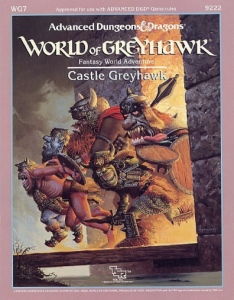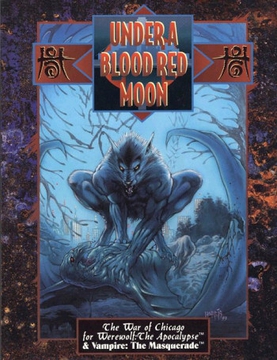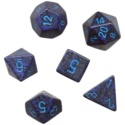
A gamemaster is a person who acts as an organizer, officiant for regarding rules, arbitrator, and moderator for a multiplayer role-playing game. They are more common in co-operative games in which players work together than in competitive games in which players oppose each other. The act performed by a gamemaster is sometimes referred to as "Gamemastering" or simply "GM-ing".

Star Frontiers is a science fiction role-playing game produced by TSR from 1982 to 1985. The game offers a space opera action-adventure setting.

The Fantasy Trip (TFT) is a fantasy tabletop role-playing game designed by Steve Jackson and published in segments by Metagaming Concepts starting in 1977 and culminating in 1980. In 2019, Steve Jackson Games republished it as The Fantasy Trip Legacy Edition.

Violence: The Role-Playing Game of Egregious and Repulsive Bloodshed is a short, 32-page role-playing game written by Greg Costikyan under the pseudonym "Designer X" and was published by Hogshead Publishing in 1999 as part of its New Style line of games.

D&D Adventurers League is the organized play association for the Dungeons & Dragons (D&D) roleplaying game which is officially administered by D&D's publisher, Wizards of the Coast. It was rebranded with the launch of D&D's 5th Edition in 2014. Prior to 2014, it was known as the Role Playing Game Association Network. The organization was originally established by D&D's previous publisher, TSR, Inc., in 1980.
The monk is a playable character class in most editions of the Dungeons & Dragons fantasy role-playing game. A D&D monk is a fantasy martial artist, specializing in unarmed combat.

Castle Greyhawk is a comedic adventure module for the Dungeons & Dragons fantasy roleplaying game set in the World of Greyhawk campaign setting. The module bears the code WG7 and was published by TSR, Inc. in 1988 for the first edition Advanced Dungeons & Dragons rules.

An adventure board game is a board game in which a player plays as a unique individual character that improves through gameplay. This improvement is commonly reflected in terms of increasing character attributes, but also in receiving new abilities or equipment.

Starfaring was the first science fiction role-playing game (RPG) published, released by Flying Buffalo in August 1976. Although it was the first to market, it didn't attract an audience, and was soon superseded by the much more popular Traveller published the following year.

Ghost of Lion Castle is a 1984 adventure module for the Dungeons & Dragons fantasy roleplaying game. Its module code is BSOLO, and it was written by Merle M. Rasmussen with cover art by Bob Maurus.

The Gates of Firestorm Peak is an adventure module for the second edition of the Advanced Dungeons & Dragons fantasy role-playing game. The adventure was published in 1996, and was written by Bruce Cordell, with cover art by Jeff Easley and interior art by Arnie Swekel.

Jennell Allyn Jaquays was an American game designer, video game artist, and illustrator of tabletop role-playing games (RPGs). Her notable works include the Dungeons & Dragons modules Dark Tower and Caverns of Thracia for Judges Guild; the development and design of conversions on games such as Pac-Man and Donkey Kong for Coleco's home arcade video game system; and more recent design work, including the Age of Empires series, Quake II, and Quake III Arena. One of her best known works as a fantasy artist is the cover illustration for TSR's Dragon Mountain adventure.

Daredevils is a tabletop role-playing game published by Fantasy Games Unlimited (FGU) in 1982 that is meant to emulate pulp magazine fiction of the 1930s.

Lords of Creation is a multi-genre tabletop role-playing game published by Avalon Hill in 1983. Although expectations were high when Avalon Hill entered the role-playing game market, the game failed to find an audience and was discontinued relatively quickly.

Dark Tower is an adventure module published by Judges Guild in 1980 for the Advanced Dungeons & Dragons fantasy role-playing game.

A gamemaster's screen, also called a GM's screen, is a gaming accessory, usually made out of either cardboard or card stock, and is used by the gamemaster to hide all the relevant data related to a tabletop role-playing game session from the players in order to not spoil the plot of the story. It also hides any dice rolls made by the gamemaster that players should not see. In addition, screens often have essential tables and information printed on the inside for the gamemaster to easily reference during play.

Tollenkar's Lair is a 1980 fantasy role-playing game adventure for The Fantasy Trip originally published by Metagaming Concepts and re-released by Steve Jackson Games in 2019.

Dungeon Planner Set 1: Caverns of the Dead is an adventure published by Games Workshop in 1984 for use with fantasy role-playing games.

Dungeon Planner Set 2: Nightmare in Blackmarsh is an adventure published by Games Workshop in 1984 for use with fantasy role-playing games.

Under a Blood Red Moon is an adventure module released in June 1993 by White Wolf Publishing for use with either of their tabletop role-playing games Vampire: The Masquerade and Werewolf: The Apocalypse, and is a part of the World of Darkness series. It is set in and around Chicago, and follows the conflict between the local vampire and werewolf communities; players take the roles of werewolves, or vampires belonging to the Camarilla or Sabbat sects.




















